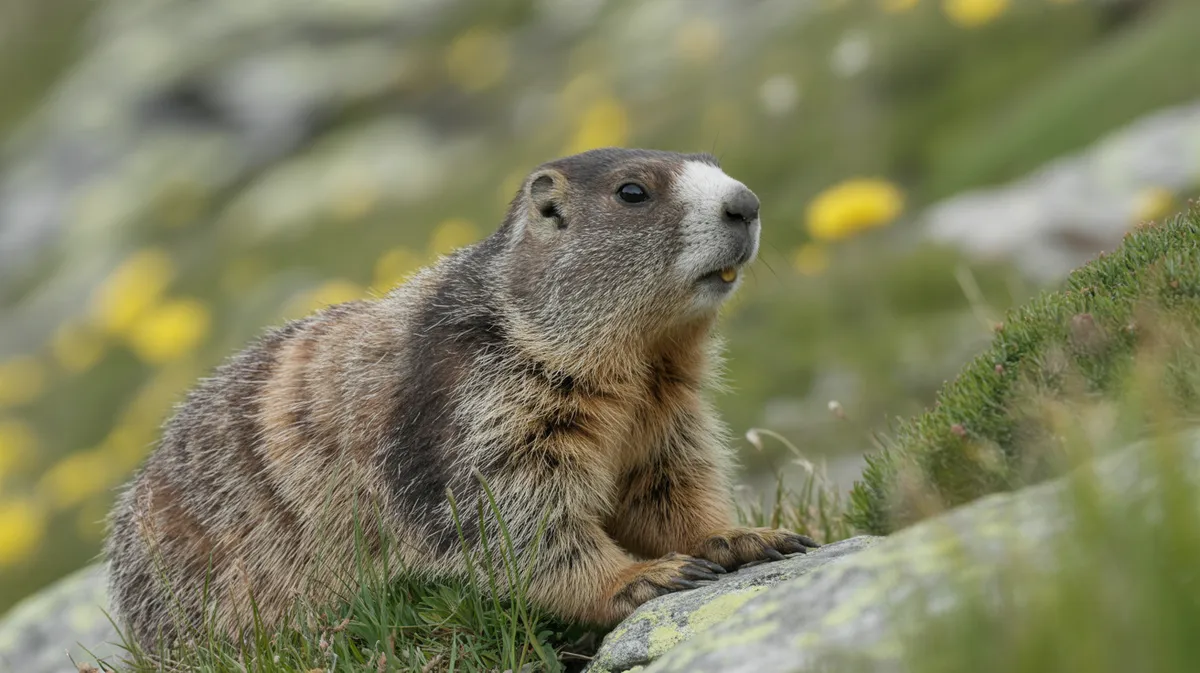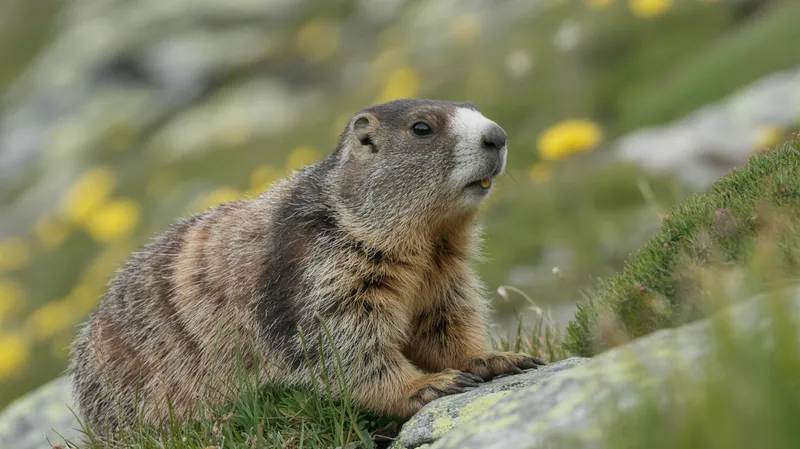
Yellow-bellied Marmot
Marmota flaviventris

Meet the Yellow-bellied Marmot
The Yellow-bellied Marmot is a large, ground-dwelling rodent native to the mountainous regions of western North America. Recognizable by its stout body, bushy tail, and yellowish fur on its belly and throat, it inhabits rocky slopes and alpine meadows. These marmots are social animals, often seen sunbathing on rocks or standing upright to watch for predators. They hibernate for over half the year, emerging in spring to feed and breed before winter returns.
Classification
Mammal
Habitat
Mountainous meadows and talus slopes
Diet
Herbivore
Lifespan
13-15 years
Conservation
Least Concern
Weight
3-7 kg
📖Fascinating Facts
Expert Hibernators
Yellow-bellied Marmots hibernate for up to eight months each year, surviving on stored body fat throughout the winter.
Rocky Residents
They prefer living in rocky outcrops or talus slopes at elevations between 2,000 and 4,300 meters (6,600–14,100 ft).
Whistle Warnings
Marmots use high-pitched whistles and trills to alert others of predators, earning them the nickname 'whistle pigs.'
📋Detailed Description
The yellow-bellied marmot (Marmota flaviventris) is a robust, ground-dwelling rodent measuring 47–68 cm (18.5–26.8 in) in length, including a bushy tail of 13–21 cm (5–8 in), and weighing 2.5–5.5 kg (5.5–12.1 lbs), with males typically larger than females. Its dense fur is grizzled brown dorsally, with a distinctive yellow to orange patch on the chest and belly, and a white blaze between the eyes. Adapted to high-elevation environments, it is found at altitudes from 1,600 to over 4,200 meters (5,200–13,800 ft), inhabiting open meadows, talus slopes, and rocky outcrops across the western United States and southwestern Canada. The species is highly social, forming colonies of up to 20 individuals, often organized around extended family groups. Marmots are diurnal, spending much of their active period foraging, sunbathing, and engaging in social behaviors such as grooming and play-fighting. Their burrows are complex, with multiple entrances and chambers for nesting, hibernation, and predator evasion. Hibernation is a key adaptation, lasting up to eight months, during which body temperature drops significantly and metabolic rates are minimized. The yellow-bellied marmot has a relatively long lifespan for a rodent, with individuals living up to 15 years in the wild. Their keen eyesight and alarm calls help them detect and evade predators, while their diet is primarily herbivorous, consisting of grasses, forbs, flowers, and occasionally insects or bird eggs.
💡 Did you know?
Despite their stocky size, Yellow-bellied Marmots can climb trees and shrubs to forage for food.
🔬Research & Sources
Wikipedia Summary
The yellow-bellied marmot, also known as the rock chuck, is a large, stout-bodied ground squirrel in the marmot genus. It is one of fourteen species of marmots, and is native to mountainous and semi-arid regions of southwestern Canada and western United States, including the Rocky Mountains, Sierra Nevada, and the Great Basin, often living above 2,000 metres. The fur is mainly brown, with a dark bushy tail, yellow chest and white patch between the eyes, and they weigh up to approximately 5 kilograms. They are highly social creatures, living in burrows in colonies of up to twenty individuals. They are diurnal and feed on plant material, insects, and bird eggs. They hibernate for approximately eight months starting in September and lasting through the winter. They have an average lifespan of 15 years.
Last Modified: 5/24/2025
🎭Behavior & Social Structure
Yellow-bellied marmots exhibit a range of complex behaviors. They are primarily active during the morning and late afternoon, avoiding midday heat. Foraging is a communal activity, with individuals often feeding within sight of one another. Sentries are posted to watch for predators such as coyotes, eagles, and foxes, emitting a sharp whistle or trill to alert the colony. Social interactions include grooming, play, and dominance displays, particularly among males during the breeding season. Marmots are territorial, with dominant males defending burrow systems and associated females. They exhibit seasonal fattening behavior in late summer to prepare for hibernation, increasing food intake and storing fat reserves. During hibernation, they enter a state of torpor, with body temperatures dropping to near ambient and heart rates slowing dramatically. Above ground, marmots are vigilant and quick to retreat to burrows at signs of danger.
👶Reproduction & Life Cycle
Breeding occurs shortly after emergence from hibernation, typically in May or June, depending on elevation and latitude. Yellow-bellied marmots are polygynous, with dominant males mating with multiple females within their territory. Gestation lasts about 30 days, after which females give birth to litters of 3–8 pups in underground nesting chambers. Pups are born altricial—blind, hairless, and helpless—and remain in the burrow for 3–4 weeks. Weaning occurs at around 4–5 weeks, after which juveniles begin to emerge and forage above ground. Females provide all parental care, while males may protect the burrow system. Most females breed for the first time at two years of age, and reproductive success is closely tied to environmental conditions and food availability.
🛡️Adaptations & Survival
Yellow-bellied marmots are highly adapted to cold, high-altitude environments. Their thick fur provides insulation, and they accumulate substantial fat reserves to survive prolonged hibernation. Physiologically, they can reduce their metabolic rate and body temperature to conserve energy during hibernation. Their burrowing behavior offers protection from predators and extreme weather, and burrow systems are often oriented to maximize solar gain. Sociality enhances predator detection and increases survival rates. Their dentition is adapted for gnawing tough vegetation, and their digestive system efficiently extracts nutrients from fibrous plant material. Behavioral adaptations include sunbathing to regulate body temperature and the use of alarm calls to coordinate group responses to threats.
🎨Cultural Significance
Yellow-bellied marmots have limited direct cultural significance but are sometimes featured in local folklore and as symbols of alpine and mountain ecosystems. In some Native American traditions, marmots are noted for their vigilance and social nature. They are occasionally referred to as 'rock chucks' in the western United States and are sometimes considered agricultural pests. Their burrowing activities can influence soil dynamics and plant communities, making them important ecosystem engineers.
🔬Recent Research & Discoveries
Recent research on yellow-bellied marmots has focused on the effects of climate change on hibernation timing and reproductive success. Long-term studies, particularly at the Rocky Mountain Biological Laboratory, have documented shifts in emergence dates and breeding phenology in response to earlier snowmelt. Studies have also explored the genetic basis of sociality, alarm calling, and hibernation physiology. Marmots are model organisms for studying the ecological impacts of environmental change, social evolution, and physiological adaptations to extreme environments.
🎥Wildlife Videos

Yellow-bellied Marmot (narrated)
This video is about Yellow-bellied Marmot (narrated) living in a mountain meadow high in the Rockies. Marmots mate when they ...
Dave Taylor Wildlife

Marmots: The Inhabitants of the Alps | Free Documentary Nature
These peculiar and roughly rabbit-sized rodents enjoy great popularity at the Großglockner in the Austrian Alps. Before the last ice ...
Free Documentary - Nature

Wild America | S7 E2 'Marmot Mountain' | Full Episode | FANGS
Title: Wild America 'Marmot Mountain' Summary: Amid the scenic springtime beauty of the wild Rockies, we meet a colony of ...
Wild America Animal Channel

Meet the Yellow-Bellied Marmot Nature's Whistle Pig!
Meet the Yellow-Bellied Marmot Nature's Whistle Pig! Discover the fascinating world of yellow-bellied marmots in our latest video!
WB

MPG Ranch : Yellow-bellied Marmots
Yellow-bellied marmots near their den on MPG Ranch in the Bitterroot Valley, Montana. Video edited by Alan Ramsey. For more ...
MPGRanch

The Magnificent Maneuver of the Yellow-Bellied Marmot!
Dive into the amusing world of yellow-bellied marmots and their hilarious sunbathing habits that help regulate body temperature, ...
Animal Fun Facts
🌍Habitat Information
The Yellow-bellied Marmot typically inhabits Mountainous meadows and talus slopes environments. Yellow-bellied Marmots have adapted to their environments with specialized features and behaviors.
Primary Habitat:
Mountainous meadows and talus slopes
More detailed habitat information will be available soon.
🛡️Conservation Status
The Yellow-bellied Marmot is currently classified as Least Concern. Conservation efforts are crucial for preserving this species for future generations.
Common Threats:
- 🏠Habitat loss and fragmentation
- 🌡️Climate change impacts
- 🎯Hunting and poaching
- 🏭Human-wildlife conflict
⚠️Threats & Conservation Challenges
Currently, the yellow-bellied marmot faces few significant threats and is classified as Least Concern by the IUCN. However, local populations may be impacted by habitat loss due to development, recreational activities, and climate change, which can alter the timing of snowmelt and plant growth, affecting hibernation and breeding cycles. Predation by coyotes, badgers, raptors, and domestic dogs is a natural mortality factor. Road mortality and poisoning (in areas where marmots are considered pests) can also pose localized risks. Climate change is an emerging concern, as shifts in temperature and snowpack may disrupt hibernation patterns and food availability.
🔬Scientific Classification
Scientific Name
Marmota flaviventris
Classification Hierarchy
🔍 About Taxonomic Classification
Taxonomic classification is a hierarchical system used by scientists to classify and organize living organisms based on shared characteristics and evolutionary relationships.
The system moves from broad categories (Kingdom) to increasingly specific ones, with each animal's scientific name typically consisting of its Genus and species.
📝Community Notes
Share your observations and insights about the Yellow-bellied Marmot with our community of wildlife enthusiasts.
Join Our Community
Sign in to share your observations and connect with fellow wildlife enthusiasts.
Sign In to ContributeNo community notes yet
Be the first to share your observations about the Yellow-bellied Marmot!
Explore Yellow-bellied Marmot
Select a tab above to learn more about this amazing animal.
📸Photo Gallery
No photos available for this animal yet.
🌟Discover More Wildlife
Continue your journey of discovery with more fascinating animals from our database
